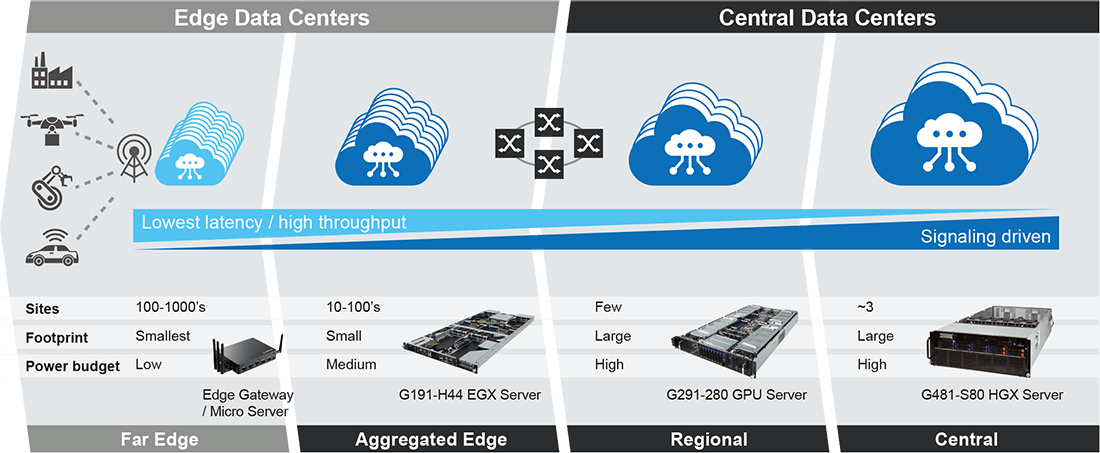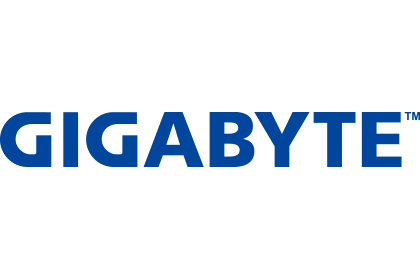EGX 人工智慧邊緣運算平台
GIGABYTE's G191-H44 EGX Server is a secure, cloud native edge computing platform for IoT, AI, 3D, XR and beyond, featuring an integrated hardware and software stack which can be used to quickly & easily deploy ready-to-use containers and AI frameworks from NGC (NVIDIA GPU Cloud).
Download White Paper
Introduction
GIGABYTE's G191-H44 EGX server is a new computing platform specifically designed to be deployed as an edge server or in an edge micro data center,
and is optimized for processing IoT sensor information (such as video, sonic or
LIDAR data) or for multimedia and interactive applications such as cloud
gaming or augmented reality. It has been fully validated and optimized for NVIDIA GPU hardware as well as NVIDIA AI application frameworks and software (such as METROPOLIS for smart cities or retail, CLARA for smart healthcare, or ISAAC for smart manufacturing), and is also is to ready to use with
popular container orchestration platforms such as RedHat OpenShift.
Edge AI Use Case Scenarios
Healthcare
Using an edge AI computing platform, patients in hospitals can be diagnosed and detected with diseases as soon as an X-ray or MRI scan has been conducted

Smart Cities - Traffic Control
In smart intersections, vehicles can be identified and the traffic lights can be controlled, so emergency vehicles can be prioritized as well as buses.

Challenges
There is a big change happening in the computing industry, and it's driven by the massive volume of data that's been generated by
billions of IoT sensors, as well as advancements in AI algorithms able to process all of this data. In order to be useful, analysis of this
data needs to happen in real time, with minimum latency so decisions can be made and acted upon quickly.
The technology now exists to enable these real-time decisions to be made – along with AI algorithms and terabytes of unstructured data
from billions of IoT sensors, we now have 5G networking and cloud-native applications driven by Kubernetes. Combining them together
now makes it possible to deploy large-scale AI at the edge of the network, away from a centralized data center.

Server Deployment in 5G Network from Edge to Cloud
However, because these systems are often distributed across many remote locations, tasks such as operating system installation,
Kubernetes deployment, device provisioning and updating, as well as standardizing runtimes, monitoring features, and drivers etc.
makes deploying and managing these systems a big challenge.
GIGABYTE and NVIDIA have therefore developed the G191-H44 EGX Edge Computing Platform, which not only features a powerful
yet space and energy efficient hardware solution ideal for GPU-accelerated workloads at the edge, but also NVIDIA Edge Stack, an
integrated software stack that simplifies and streamlines the entire process of edge AI server deployment and management.
GIGABYTE EGX Platform Benefits
A Complete Hardware & Software Stack for Edge AI
GIGABYTE's EGX Platform integrates our G191-H44 1U dual 2nd Generation Intel Xeon Scalable Family processor server, 4 x NVIDIA Tesla® T4 accelerators and Mellanox Connect-X 5 smart NICs together with NVIDIA Edge Stack, a hardened software stack built for AI inferencing workloads using containers. NVIDIA Edge Stack provides an enterprise grade container orchestration environment that runs on top of GIGABYTE's G191-H44 server to support all kinds of AI models, and can connect to cloud IoT services such as RedHat OpenShift, AWS GreenGrass, or Azure IoT Edge.
NVIDIA Edge Stack includes NVIDIA drivers, a CUDA Kubernetes plug-in, a CUDA Docker container runtime, CUDA-X libraries and containerized AI frameworks and applications, including TensorRT, TensorRT Inference Server and DeepStream, and can be easily integrated together with leading third party Kubernetes orchestration platforms such as Red Hat OpenShift and be used to deploy a variety of AI-ready containers from NGC (NVIDIA GPU Cloud).

GIGABTYE Server G191-H44 EGX Platform
Easy Deployment with GPU Operator
GIGABYTE's EGX server simplifies the deployment and management of GPU-accelerated AI micro-clouds for all industries. The
EGX stack is optimized to run container-based applications on cloud-native Kubernetes infrastructure with rapid installation via a
Helm chart. This installation gets simpler with NVIDIA GPU Operator, which standardizes and automates the deployment of all the
necessary components for provisioning GPU-enabled Kubernetes clusters.
NVIDIA GPU Operator uses containers to automate the setup of a GPU-powered node. The GPU driver, runtime, Kubernetes plug-in,
and monitoring plug-in can now be managed by EGX GPU Operator. This infrastructure also manages the complex upgrading of the
driver based on cluster policy.

EGX Structure
Easy to Implement AI with NGC Containers & Frameworks
GIGABYTE's G191-H44 EGX Platform is built to be used with NVIDIA NGC (NVIDIA GPU Cloud), an online, free to use platform
(and with optional enterprise grade support) which features GPU accelerated containers, a container registry and software for
deploying and running these containers. NGC is the go-to place for GPU-optimized and curated containers, deep learning models,
and scripts that enable users to get the maximum value from their GPU infrastructure. New NGC containers are published monthly
and offer the latest features and superior performance on NVIDIA GPUs, can be used with multi-GPU & multi-node systems for
scale-up & scale-out environments, and feature support for Docker & Singularity runtimes as well as VMware vSphere.
GIGABYTE's G191-H44 has been validated as a NGC Ready for Edge server, so that NGC containers, models or scripts can be quickly and easily deployed to run inferencing or other GPU-accelerated workloads. NGC has now also expanded to include support for Helm charts, which are essential for fast deployment on any enterprise Kubernetes platform. NGC will include a Helm chart for GPU Operator deployment. NGC also features NVIDIA Application frameworks that can be easily run on top of NVIDIA EGX-Stack. An example is NVIDIA Metropolis IoT, which can be used for image processing in real time from streams of CCTV cameras for intelligent video analytics and applications that can be used to enable smart cities.
GIGABYTE's G191-H44 has been validated as a NGC Ready for Edge server, so that NGC containers, models or scripts can be quickly and easily deployed to run inferencing or other GPU-accelerated workloads. NGC has now also expanded to include support for Helm charts, which are essential for fast deployment on any enterprise Kubernetes platform. NGC will include a Helm chart for GPU Operator deployment. NGC also features NVIDIA Application frameworks that can be easily run on top of NVIDIA EGX-Stack. An example is NVIDIA Metropolis IoT, which can be used for image processing in real time from streams of CCTV cameras for intelligent video analytics and applications that can be used to enable smart cities.

NVIDIA AI - Cloud to Edge
GIGABYTE EGX Server Platform
Get started today deploying real-time AI at the edge with GIGABYTE's G191-H44 EGX server, powered by NVIDIA GPUs, applications and frameworks.
Related Technologies
What is edge computing? Edge computing is a type of computing network architecture, where computation is moved as close to the source of data as possible, in order to reduce latency and bandwidth use. The aim is to reduce the amount of computing required to be performed in a centralized, remote location (i.e. the "cloud") far away from the source of the data or the user who requires the result of the computation, thus minimizing the amount of long-distance communication that has to happen between a client and server. Rapid advances in technology allowing for miniaturization and increased density of computing hardware as well as software virtualization have made edge computing more feasible in recent years.Learn More:《What is Edge Computing? Definition and Cases Explained.》
Artificial Intelligence (AI) is a broad branch of computer science. The goal of AI is to create machines that can function intelligently and independently, and that can work and react the same way as humans. To build these abilities, machines and the software & applications that enable them need to derive their intelligence in the same way that humans do – by retaining information and becoming smarter over time.
AI is not a new concept – the idea has been in discussion since the 1950s – but it has only become technically feasible to develop and deploy into the real world relatively recently due to advances in technology – such as our ability to now collect and store huge amounts of data that are required for machine learning, and also the rapid increases in processing speeds and computing capabilities which make it possible to process the data collected to train a machine / application and make it "smarter".
The Internet of Things (IoT) refers to a network of devices connected to the internet that can record or receive data without requiring any human to machine interaction. These devices can be any kind of physical object in daily life, business or industry – for example, the thermostat in your home, a trash can on the roadside, or a piece of equipment on a factory production line.
加速實現你的科技創新
業務洽詢























